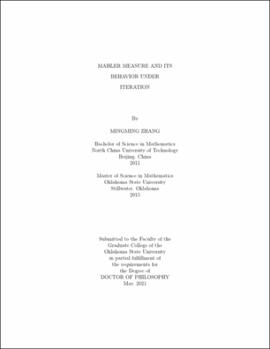| dc.contributor.advisor | Fili, Paul | |
| dc.contributor.author | Zhang, Mingming | |
| dc.date.accessioned | 2021-09-24T13:33:10Z | |
| dc.date.available | 2021-09-24T13:33:10Z | |
| dc.date.issued | 2021-05 | |
| dc.identifier.uri | https://hdl.handle.net/11244/330896 | |
| dc.description.abstract | For an algebraic number $\alpha$ we denote by $M(\alpha)$ the Mahler measure of $\alpha$. Mahler measure is a height function on polynomials with integer coefficients. Moreover, as $M(\alpha)$ is again an algebraic number (indeed, an algebraic integer), $M(\cdot)$ is a self-map on $\mathbb{A}$(Sometimes denoted $\overline{\mathbb{Q}}$), and therefore defines a dynamical system. The \emph{orbit size} of $\alpha$, denoted $\# \mathcal{O}_M(\alpha)$, is the cardinality of the forward orbit of $\alpha$ under $M$. In this thesis, we will start by introducing the background of Mahler measure as a height and a dynamical system, we will review previous results on the orbit sizes of lower degree algebraic integers and lower degree number fields, then we discuss results on the orbit sizes of algebraic integers with degree at least 3 and non-unit norm. After that, we will turn our focus to the behavior of algebraic units, which are of interest in Lehmer's problem. We will prove the results regarding algebraic units of degree 4 and discuss that if $\alpha$ is an algebraic unit of degree $d\geq 5$ such that the Galois group of the Galois closure of $\mathbb{Q}(\alpha)$ contains $A_d$, then the orbit size must be 1, 2 or $\infty$. Furthermore, we will show that there exist units with orbit sizes larger than 2. We will also show a few experimental results on the behavior of $(\log(M^{n}(\alpha)))$. In chapter five, we will prove partial results on the classification of number fields based on the existence of wandering points. | |
| dc.format | application/pdf | |
| dc.language | en_US | |
| dc.rights | Copyright is held by the author who has granted the Oklahoma State University Library the non-exclusive right to share this material in its institutional repository. Contact Digital Library Services at lib-dls@okstate.edu or 405-744-9161 for the permission policy on the use, reproduction or distribution of this material. | |
| dc.title | Mahler measure and its behavior under iteration | |
| dc.contributor.committeeMember | Wright, David | |
| dc.contributor.committeeMember | Pritsker, Igor | |
| dc.contributor.committeeMember | Molnar, Adam | |
| osu.filename | Zhang_okstate_0664D_17134.pdf | |
| osu.accesstype | Open Access | |
| dc.type.genre | Dissertation | |
| dc.type.material | Text | |
| dc.subject.keywords | arithmetic dynamics | |
| dc.subject.keywords | dynamical system | |
| dc.subject.keywords | lehmer's conjecture | |
| dc.subject.keywords | lehmer's problem | |
| dc.subject.keywords | mahler measure | |
| dc.subject.keywords | number theory | |
| thesis.degree.discipline | Mathematics | |
| thesis.degree.grantor | Oklahoma State University | |
